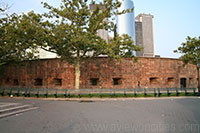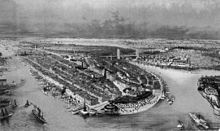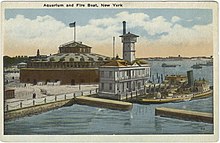Located at the southern tip of Manhattan Island in Battery Park, Castle
Clinton stands where New York City began, approximately two blocks west
of where Fort Amsterdam stood almost 400 years ago when New York City
was known by the Dutch name New Amsterdam.
Castle Clinton or Fort Clinton, previously known as Castle Garden, is a circular sandstone fort now located in Battery Park, in Manhattan, New York City. Built from 1808 to 1811, it was the first U.S. immigration station (predating Ellis Island), where more than 8 million people arrived in the United States from 1855 to 1890. Over its active life, it has also functioned as a beer garden, exhibition hall, theater, and public aquarium. Castle Clinton National Monument was listed on the National Register of Historic Places on October 15, 1966.
Castle Clinton, originally known as West Battery and sometimes as Southwest Battery, was built on a small artificial island just off shore. Construction began in 1808 and the fort was completed in 1811, though modifications continued through the 1820s. Designed by John McComb Jr. and Jonathan Williams West Battery was roughly circular shaped with a radius of approximately 92 feet (28 m), contained a red brick facade, and had 28 "thirty-two pounder" cannons. About one-eighth of the circle was left "unfinished", with a straight wall constructed between the "unfinished" segments.[10][13] West Battery was intended to complement the three-tiered Castle Williams, the East Battery, on Governors Island. Though garrisoned in 1812, the fort never saw action in any war.[16]
By 1815, West Battery was renamed Castle Clinton, its current official name, in honor of New York City Mayor DeWitt Clinton (who eventually became Governor of New York).[10][3][16] The castle itself was converted to administrative headquarters for the Army. Simultaneously, at the end of the war, there was a public movement to build a park in the Battery area.[16] A 1816 proposal to construct two small office buildings at Castle Clinton was canceled due to public opposition, and the castle lay dormant for three years.[18][16] Even in 1820, it was only being used as a paymaster's quarters and storage area.[19] The United States Army stopped using the fort in 1821, and it was ceded to the city by an act of Congress in March 1822.[19][20][21] By then, the bridge leading to Castle Clinton was frequently used by fishermen who were catching fish from the bridge.[10]
The fort was leased to New York City as a place of public entertainment in June 1824. It opened as Castle Garden on July 3, 1824, a name by which it was popularly known for most of its existence.It served in turn as a promenade, beer garden/restaurant, exhibition hall, opera house, and theater. Designed as an open-air structure, it was eventually roofed over to accommodate these uses.
In 1850, the castle was the site of two concerts given for charity by Swedish soprano Jenny Lind to initiate her American tour. A year later, European dancing star Lola Montez performed her notorious "tarantula dance" in Castle Garden. In 1853–54, Louis-Antoine Jullien, the eccentric French conductor and composer of light music, gave dozens of very successful concerts mixing classical and light music.The Max Maretzek Italian Opera Company notably staged the New York premieres of Gaetano Donizetti's Marino Faliero on June 17, 1851, and Giuseppe Verdi's Luisa Miller on July 20, 1854, at Castle Garden.[Landfill was used to expand Battery Park during the 1860s, at which point the island containing the fort was incorporated into the rest of Manhattan Island.
After many unnecessary deaths, and scandals over immigration workers cheating and stealing from immigrants, the immigration center was moved to Ellis Island. Most of Castle Clinton's immigrant passenger records were destroyed in a fire that consumed the first structures on Ellis Island on June 15, 1897but it is generally accepted that over 8 million immigrants (and perhaps as many as 12 million) were processed during its operation. Called Kesselgarten by Yiddish-speaking Eastern European Jews, a Kesselgarten became a generic term for any situation that was noisy, confusing or chaotic, or where a "babel" of languages was spoken (a reference to the multitude of languages heard spoken by the immigrants from many countries at the site).[citation needed] Prominent persons associated with the administration of the immigrant station included Gulian Crommelin Verplanck, Friedrich Kapp, and John Alexander Kennedy.
From 1896 to 1941, Castle Garden was the site of the New York City Aquarium.
For many years, it was the city's most popular attraction, drawing
hundreds of thousands of visitors each year. The structure was
extensively altered and roofed over to a height of several stories,
though the original masonry fort remained.
In 1941, Triborough Bridge and Tunnel Authority Commissioner Robert Moses wanted to tear the structure down completely, claiming that this was necessary to build the Brooklyn–Battery Tunnel. To expedite construction of the tunnel, the city closed the New York Aquarium and moved its fish to other aquariums in September 1941. Moses advocated for the demolition of Castle Clinton, but preservationists who opposed Moses's proposed action asked a federal judge to grant an injunction to prevent demolition.Even though Moses initially got the injunction dismissed the public outcry prevented his effort at demolition. However, the aquarium was closed and not replaced until Moses opened a new facility on Coney Island in 1957Moses subsequently proposed creating a Fort Clinton memorial on the site, but would only keep Castle Clinton if the federal government agreed to pay for its restoration. Albert S. Bard, Walter D. Binger, and other civic reformers advocated to save the castle, which resulted in both houses of the United States Congress passing legislation to make the castle a U.S. historic monument. President Harry S. Truman signed the legislation on August 12, 1946.
Although Castle Garden had been designated a national monument, the city still owned the property. In July 1947, the New York City Board of Estimate voted to demolish Castle Garden However, the Board delayed the demolition for another year to allow the federal government to review the decision In May 1948, the Board voted to demolish the castle for the sixth time in as many years.
After another year of discussion, the New York State Assembly reversed its decision to allow the castle to be demolished. The federal government finally obtained the property on July 18, 1950, after the city deeded the land and castle to the federal government.A project to renovate Castle Clinton was announced in 1956 after funding had been secured
A major rehabilitation took place in the 1970s, and Castle Clinton reopened in 1975. It is currently administered by the National Park Service and is a departure point for visitors to the Statue of Liberty and Ellis Island. In addition, the fort contains a small history exhibit and occasionally hosts concerts. Castle Clinton has largely been restored to its original appearance.
Before Ellis Island was built, this castle served as a port of immigration for those arriving in America. It functioned in this capacity from 1855 until 1890 - after about 8 million immigrants had entered the US via Castle Clinton - and was later replaced by the much more famous island in the middle of Upper New York Bay. After the immigration station closed, Castle Clinton became the New York Aquarium.
Today the site houses the ticket office for the Statue of Liberty – Ellis Island ferry. And a small interpretive display of its history. Castle Clinton receives an annual visitation of over 3 million people, making it one of the most visited National Park Service sites in the country.
Castle Clinton is located in historic Battery Park. It is only directly accessible by foot, bicycle, or wheelchair. You cannot drive directly to the site. Local parking is nearly impossible to find and expensive. All public transportation options are located outside of Battery Park.
Construction
Clinton Castle is the only remaining fortress in Manhattan. It was built
in 1808-1811 on an artificial island and was known as the West Battery.
The circular brownstone fort was designed by John McComb Jr. and Lt.
Col Jonathan Williams.
 Intended to defend the city during the War of 1812 against
Great-Britain, it was a complement to the East Battery / Castle Williams
fortification on Governor's Island. Neither fort saw any military
action.
Intended to defend the city during the War of 1812 against
Great-Britain, it was a complement to the East Battery / Castle Williams
fortification on Governor's Island. Neither fort saw any military
action.

Castle Clinton
Castle Clinton or Fort Clinton, previously known as Castle Garden, is a circular sandstone fort now located in Battery Park, in Manhattan, New York City. Built from 1808 to 1811, it was the first U.S. immigration station (predating Ellis Island), where more than 8 million people arrived in the United States from 1855 to 1890. Over its active life, it has also functioned as a beer garden, exhibition hall, theater, and public aquarium. Castle Clinton National Monument was listed on the National Register of Historic Places on October 15, 1966.
Original use
Castle Clinton stands slightly west of where Fort Amsterdam was built in 1626, when New York City was known by the Dutch name New Amsterdam.Fort Amsterdam was demolished by 1790 after the American Revolutionary War. Proposals for a new fort were made after two separate war scares involving Britain and France in the 1790s, but neither plan was ultimately carried out. By 1805, there were growing tensions between Britain and the U.S., which would mark the run-up to the War of 1812. Late that year, Lieutenant Colonel Jonathan Williams of the United States Army Engineers began planning a series of fortifications in New York Harbor. Williams was part of a group of three commissioners who, in 1807, submitted a report that recommended the construction of fortifications in New York Harbor.Castle Clinton, originally known as West Battery and sometimes as Southwest Battery, was built on a small artificial island just off shore. Construction began in 1808 and the fort was completed in 1811, though modifications continued through the 1820s. Designed by John McComb Jr. and Jonathan Williams West Battery was roughly circular shaped with a radius of approximately 92 feet (28 m), contained a red brick facade, and had 28 "thirty-two pounder" cannons. About one-eighth of the circle was left "unfinished", with a straight wall constructed between the "unfinished" segments.[10][13] West Battery was intended to complement the three-tiered Castle Williams, the East Battery, on Governors Island. Though garrisoned in 1812, the fort never saw action in any war.[16]
By 1815, West Battery was renamed Castle Clinton, its current official name, in honor of New York City Mayor DeWitt Clinton (who eventually became Governor of New York).[10][3][16] The castle itself was converted to administrative headquarters for the Army. Simultaneously, at the end of the war, there was a public movement to build a park in the Battery area.[16] A 1816 proposal to construct two small office buildings at Castle Clinton was canceled due to public opposition, and the castle lay dormant for three years.[18][16] Even in 1820, it was only being used as a paymaster's quarters and storage area.[19] The United States Army stopped using the fort in 1821, and it was ceded to the city by an act of Congress in March 1822.[19][20][21] By then, the bridge leading to Castle Clinton was frequently used by fishermen who were catching fish from the bridge.[10]
19th century
Exhibition hall
The Bay and Harbor of New York by Samuel Waugh (1814–1885), depicting the castle in 1848
First appearance of Jenny Lind in the U.S. at Castle Garden, September 11, 1850 (engraving by Currier and Ives)
In 1850, the castle was the site of two concerts given for charity by Swedish soprano Jenny Lind to initiate her American tour. A year later, European dancing star Lola Montez performed her notorious "tarantula dance" in Castle Garden. In 1853–54, Louis-Antoine Jullien, the eccentric French conductor and composer of light music, gave dozens of very successful concerts mixing classical and light music.The Max Maretzek Italian Opera Company notably staged the New York premieres of Gaetano Donizetti's Marino Faliero on June 17, 1851, and Giuseppe Verdi's Luisa Miller on July 20, 1854, at Castle Garden.[Landfill was used to expand Battery Park during the 1860s, at which point the island containing the fort was incorporated into the rest of Manhattan Island.
Immigration holding center
In the first half of the 19th century, most immigrants arriving in New York City landed at docks on the east side of the tip of Manhattan, around South Street. On August 1, 1855, Castle Clinton became the Emigrant Landing Depot, functioning as the New York State immigrant processing center (the nation's first such entity). It was operated by the state until April 18, 1890, when the U. S. government assumed control of immigration processing, soon moving the center to the larger, more isolated Ellis Island facility on January 2, 1892.After many unnecessary deaths, and scandals over immigration workers cheating and stealing from immigrants, the immigration center was moved to Ellis Island. Most of Castle Clinton's immigrant passenger records were destroyed in a fire that consumed the first structures on Ellis Island on June 15, 1897but it is generally accepted that over 8 million immigrants (and perhaps as many as 12 million) were processed during its operation. Called Kesselgarten by Yiddish-speaking Eastern European Jews, a Kesselgarten became a generic term for any situation that was noisy, confusing or chaotic, or where a "babel" of languages was spoken (a reference to the multitude of languages heard spoken by the immigrants from many countries at the site).[citation needed] Prominent persons associated with the administration of the immigrant station included Gulian Crommelin Verplanck, Friedrich Kapp, and John Alexander Kennedy.
20th century to present
Aerial view illustration of Manhattan, showing Castle Garden at its tip, ca. 1880
The New York Aquarium was once housed at Castle Garden (image before 1923)
In 1941, Triborough Bridge and Tunnel Authority Commissioner Robert Moses wanted to tear the structure down completely, claiming that this was necessary to build the Brooklyn–Battery Tunnel. To expedite construction of the tunnel, the city closed the New York Aquarium and moved its fish to other aquariums in September 1941. Moses advocated for the demolition of Castle Clinton, but preservationists who opposed Moses's proposed action asked a federal judge to grant an injunction to prevent demolition.Even though Moses initially got the injunction dismissed the public outcry prevented his effort at demolition. However, the aquarium was closed and not replaced until Moses opened a new facility on Coney Island in 1957Moses subsequently proposed creating a Fort Clinton memorial on the site, but would only keep Castle Clinton if the federal government agreed to pay for its restoration. Albert S. Bard, Walter D. Binger, and other civic reformers advocated to save the castle, which resulted in both houses of the United States Congress passing legislation to make the castle a U.S. historic monument. President Harry S. Truman signed the legislation on August 12, 1946.
Brooklyn-Battery Bridge
In 1939, city planner Robert Moses - who made a career destroying
historic houses and neighborhoods to build new highways - wanted to
demolish Castle Clinton to make way for a new bridge connecting Battery
with Brooklyn. President Franklin Roosevelt however personally
intervened and the project was abandoned. After the New York Aquarium
moved to Coney Island
in 1941, many politicians wanted to demolish the structure, but
concerned citizens rallied to save it and in 1946 it received its
National Monument designation.
Although Castle Garden had been designated a national monument, the city still owned the property. In July 1947, the New York City Board of Estimate voted to demolish Castle Garden However, the Board delayed the demolition for another year to allow the federal government to review the decision In May 1948, the Board voted to demolish the castle for the sixth time in as many years.
After another year of discussion, the New York State Assembly reversed its decision to allow the castle to be demolished. The federal government finally obtained the property on July 18, 1950, after the city deeded the land and castle to the federal government.A project to renovate Castle Clinton was announced in 1956 after funding had been secured
A major rehabilitation took place in the 1970s, and Castle Clinton reopened in 1975. It is currently administered by the National Park Service and is a departure point for visitors to the Statue of Liberty and Ellis Island. In addition, the fort contains a small history exhibit and occasionally hosts concerts. Castle Clinton has largely been restored to its original appearance.
Before Ellis Island was built, this castle served as a port of immigration for those arriving in America. It functioned in this capacity from 1855 until 1890 - after about 8 million immigrants had entered the US via Castle Clinton - and was later replaced by the much more famous island in the middle of Upper New York Bay. After the immigration station closed, Castle Clinton became the New York Aquarium.
Today the site houses the ticket office for the Statue of Liberty – Ellis Island ferry. And a small interpretive display of its history. Castle Clinton receives an annual visitation of over 3 million people, making it one of the most visited National Park Service sites in the country.
Castle Clinton is located in historic Battery Park. It is only directly accessible by foot, bicycle, or wheelchair. You cannot drive directly to the site. Local parking is nearly impossible to find and expensive. All public transportation options are located outside of Battery Park.






































































